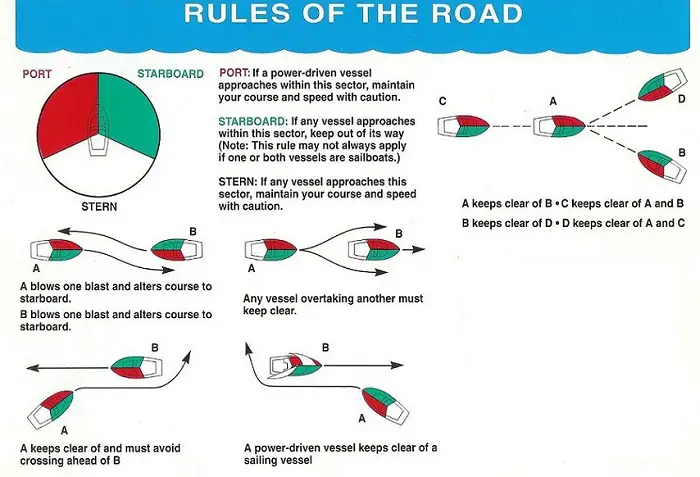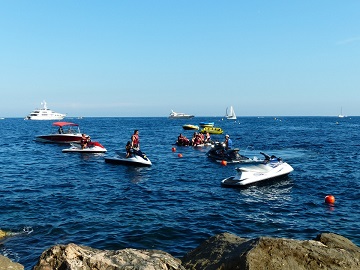aa) Should not overlap or cross directly in front of them
bb) Slow down and use caution when passing by each other
cc) Follow the rules of the water (crossing rule)
The best answer is C. Follow the rules of the water.

A motorboat is crossing paths with a PWC. What action should be taken?
When a motorboat and a PWC cross paths, the vessel which has the other on her starboard side must keep out of the way.
ColRegs Rule-15 (crossing rule) states that “when two power-driven vessels are crossing so as to involve risk of collision, the vessel which has the other on her own starboard side shall keep out of the way and shall, if the circumstances of the case admit, avoid crossing ahead of the other vessel.”
What is a PWC boat?
In a nutshell, PWC (Personal Watercraft) is defined by law as “a small watercraft which uses an outboard propeller or motor, driven motor, or inboard engine powering a water jet pump”. Essentially the PWC provides propulsion with some form of power and it can be operated by someone sitting, standing, or kneeling on the boat.

What are the “rules of the road”?
These regulations have been agreed upon by many different countries in an attempt to prevent accidents from happening while using the ocean for travel. An example of this is the International Regulations for Preventing Collisions at Sea, commonly known as COLREGS. The ocean is a big place, and not all vessels know how to navigate international waters. In order to keep the seas safe for everyone who uses them, there are some rules that need to be followed at sea.
Does a PWC need to follow the “rules of the road”?
Yes, A PWC needs to follow the rules of the road at sea. A person operating a PWC must know and follow the rules of navigation. Every vessel that uses the international water has to follow the rules of navigation.
What action should be taken when a motorboat crosses paths with a PWC from the port side?
In case a motorboat is crossing paths with a PWC from the port side, the motorboat should keep out of the way. The PWC should slow down and use caution. In this situation, the motorboat is the give-way vessel and the PWC is the stand-on vessel.
What action should be taken when a motorboat crosses paths with a PWC from the starboard side?
In this case, the PWC should keep out of the way. The motorboat should observe the PWC. If the circumstances of the situation allow it, the motorboat should take action to avoid a collision.
As per the rules, it’s the responsibility of both parties to take action if needed. This is the most important rule to consider as a priority.
What action should be taken when a motorboat and a PWC are approaching head-on?
When a motorboat and a PWC are approaching head-on, the law states that they should both turn to starboard.
If two motorboats meet head-on and the boats are on reciprocal courses or nearly reciprocal courses but slightly offset to port, it’s important that one boat turns starboard as soon as they see an impending collision (even if there isn’t any immediate danger).
What should a sailboat do when approaching a PWC?
The motorboat (PWC) is the give-way vessel, and the sailboat is the stand-on vessel. If a sailing vessel under sail is about to cross paths with a motorboat (PWC), the PWC should change its course and speed. The sailboat should not do anything to interfere with the PWC except closely monitor its movements.
What should the operator of a give-way vessel do?
Give-way vessels are responsible for stopping, slowing down, or changing course in order to avoid an accident. The operator of a give way vessel should have a contingency plan ready before they approach an intersection with another vessel so that he can take early and substantial action. And, when taking any action he should make it clear that he is doing so.
What should the operator of a stand-on vessel do?
The operator of a stand-on vessel should do nothing. However, if the giveaway vessel is not taking appropriate action, it’s best for the stand-on vessel to assume that the other boat will not be giving way and to take action by changing its course or speed.
What do courteous PWC operators always do?
Courteous PWC operators stay aware of others at all times and follow all rules and regulations. They control their speed, noise, and wake. Whether they are operating near other vessels or docks, they take into consideration the safety of others.
We all know how annoying it is to have a noisy, speeding PWC coming up on our side. Remember that other boaters may not understand what you’re doing so it’s important to signal when turning or stopping in their lane of travel. Be sure to slow down around docks and swimming areas because people can easily step out into your path without realizing it.
What should boaters do for their own safety?
From must-have safety equipment to how to operate a vessel, boat owners should make sure they are always prepared. They should secure a VHF radio, a sound-producing device, and flares. It’s also wise to check the weather forecast before heading out.
Boaters should keep in mind:
- Keep a life jacket or PFD.
- Keep emergency equipment.
- Avoid overloading.
- Use common sense.
- File a float plan.
- Check weather.
- Must take a safety course.
- Follow all the rules.
